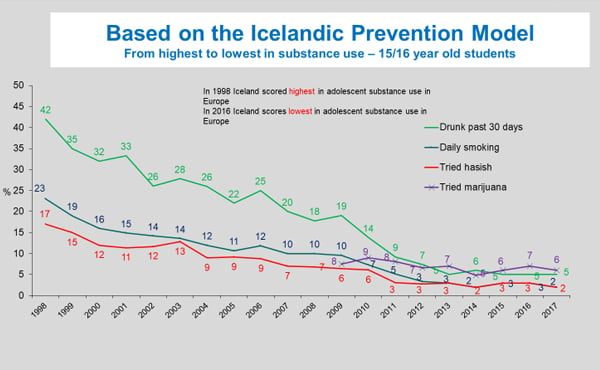Using the Icelandic Model to Prevent Teenage Substance Use
October 09, 2019 | ASTHO Staff
Harvey Milkman, PhD, is psychology professor emeritus at Metropolitan State University in Denver and principal consultant for the U.S.-Russia Peer-to-Peer Dialogue Program serving at-risk youth. He has devoted his life to researching youth substance abuse prevention and has published numerous articles and co-authored the book Pathways to Self-Discovery and Change: Criminal Conduct and Substance Abuse Treatment for Adolescents.
From 1992-2002, Milkman was the director of Project Self Discovery: Artistic Alternatives for At-Risk Youth, a national demonstration model that received funding from the Center for Substance Abuse Prevention and the Office of Juvenile Justice and Delinquency Prevention. Milkman received a Fulbright-Hays Lectureship Award and has represented the United States as a consultant and featured speaker in Australia, Brazil, Iceland, the Netherlands, Peru, Turkey, and former Yugoslavia. Milkman delivered the keynote address “Healthy Futures: Creating Environments for Positive Youth Development” at ASTHO’s Annual Meeting, on Sept. 23.

Iceland has seen incredible success at reversing teenage substance abuse. What key factors from the country’s approach should state and territorial public health leaders be aware of?
Communities must adopt a long-term, prevention-based perspective for reducing teenage substance misuse. As noted in this Health Promotion International article, Iceland’s success has accrued over a 20 year period. However, there are unique and complicated hurdles to developing a successful substance use prevention approach in the U.S., including:
- National, state and local governments prioritize law enforcement and treatment over prevention. Most funding is allocated to crisis-oriented law enforcement, treatment, or punishment for attempted suicide, overdose, burglary, robbery, and assault.
- Youth service agencies vigorously compete for limited funds provided through national, state, and local governments, interfering with beneficial inter-agency alliances.
- There is an absence of consensus among youth advocates and prevention/intervention specialists on what works in substance use prevention.
- Communities differ greatly in terms of types of substance use problems and kinds of available prevention resources, making it unrealistic to transpose what works in one community to another.
- Self-report survey data on the life conditions of youth are often based on statewide information without regard to the specific local school or municipality conditions affecting youth.
- Feedback from youth surveys is often not delivered in a timely manner, and thus the community response to the information is often irrelevant to current life conditions.
What steps can state and territorial health officials take to reduce risk factors for substance abuse in their jurisdictions?
State and territorial health officials should organize a broad network of stakeholders in adolescent well-being that includes parent groups, health personnel, schools (including teachers, counselors, and administrators), research scientists, politicians, media, sports organizations, and corporations. These groups can work together to:
- Increase the time that adolescents and their families spend together.
- Postpone the onset of alcohol, tobacco, or other drug use until age 21 and older.
- Increase child and adolescent participation in structured and organized youth activities supervised by trusted adults.
Successful substance abuse prevention efforts are based on three proven principles:
- Evidence-based practice.
- Using a local, community-based approach.
- Creating a dialogue among research, policy, and practice.
How has the Icelandic model leveraged partnerships and collaborations with nontraditional organizations and stakeholders to address the country’s unique challenges?
Much of the success of the Iceland model can be attributed to the commitment and involvement of patrons from the highest levels of Icelandic society. Ólafur Ragnar Grímsson, president of Iceland from 1996-2016, is the patron of the Planet Youth substance use prevention program. In addition, Reykjavik’s mayor, Dagur Eggertsson, put forth the slogan “Love Without Hesitation,” which is at the heart of Iceland’s success.
A child’s well-being in the context of parents, free-time activity, peers, and school are of paramount importance to substance use prevention. Two key elements have been foundational in Iceland’s success:
- The National Parental Organization introduced parental agreements that address items like curfew and alcohol use. This agreement is introduced at school parental meetings, and parents of children in each class are invited to sign the agreement.
- A municipality coupon subsidizes each child to participate in recognized after-school activities (like sports or music, for example) regardless of the economic status of the family. These vouchers enable those in charge of these activities to provide educated staff and invaluable mentorship experiences.
What is your vision for the future of substance abuse prevention and treatment?
The key to successful substance abuse prevention is an integrated, comprehensive, and evidence-based approach to four principal areas of a child’s life: parents, peers, school, and organized free-time activity.
There must be political will backed by grassroots momentum to provide adequate funding for engaging youth in healthy after-school and neighborhood activities, guided by trusted and skilled teachers, artists and coaches. All stakeholders understand that artistic, intellectual, or athletic proficiency is second to character strength and developing the capacity for enjoyment while maintaining a substance-free lifestyle.